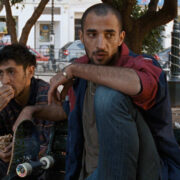Designing Dystopia: Interview With SEE And THE HANDMAID’S TALE Costume Designer Natalie Bronfman
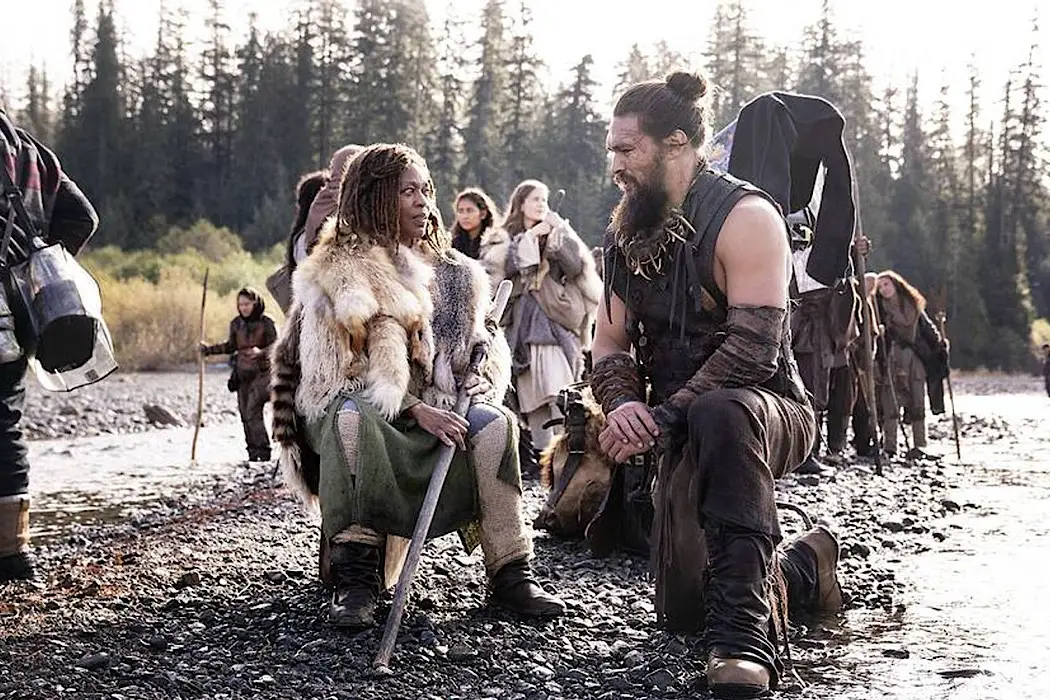
Film critic, Ithaca College and University of St Andrews graduate,…
Distant futures, fantasy dystopias, and second-generation supervillains. Such are the worlds whose costumes are designed by Natalie Bronfman, a visionary craftsperson who rose through the ranks of the wardrobe department as an assistant or buyer on films like the Dawn of the Dead and Carrie remakes, A History of Violence, The Pacifier, Cheaper By the Dozen 2, and the Hulu series 11.22.63.
Bronfman returned to Hulu for The Handmaid’s Tale, first serving as a buyer and supervisor for the hit series’ much-lauded wardrobe department, then taking over the costume design for Season Three. She designed the luxe suits and sweaty, bullet hole-ridden jackets on Quibi’s Most Dangerous Game. And she took the reins for the wardrobes on Apple TV+’s sight-based dystopian epic See for its second and third seasons. She also designed the costumes for Gotham Knights on the CW.
I had the chance to speak with Bronfman about her artistic process, including her approaches to color and practical design, and her thoughts on political protests, animal furs, and communicating character psychology through costume design.
This interview has been edited for clarity.
Clement Obropta for Film Inquiry: You studied costume history in Europe, right?
I went to school in Rome. It’s amazing to be able to study elsewhere. I ended up with a Ph.D. from there.
Is that how you got into costume design, through studying costume history in Rome?
Natalie Bronfman: I wanted to be an opera singer when I was a kid, and I already knew how to sew and draw. I was good, but I wasn’t top-notch at singing, and I wanted to stay in the environment and thought, well, I already sew, and I can draw, so naturally I ended up in costuming. Somehow, it doesn’t pay a lot of money… it’s like being a nun. It’s a calling. You’re lucky if you can afford a basement apartment sometime you’re in your thirties. I ended up falling into film by accident.
The Handmaid’s Tale, which you helmed as the show’s costume designer in Season Three, has a long history now of its red handmaid cloaks appearing as costumes at women’s rights protests and demonstrations. And now, with Roe v. Wade struck down in the U.S., the costume is appearing again at pro-abortion rights demonstrations.
Natalie Bronfman: I live in Canada, so I’m very lucky the rules don’t apply here. I’m shocked. I don’t know. I don’t even have words for it. There’s been something going around the internet as well, saying, “Don’t forget to set your clocks back 50 years starting tomorrow morning.” Looking at it as a person from another country — and I’m also very European because I was born and raised there — [the decision] has almost knocked [the U.S.] out of the position of a first-world country. That’s my opinion. I’m just shocked at something like that in a country that the rest of the world used to look at as so progressive and innovative […] and for this to come through and be voted on and pass? My jaw dropped. I don’t even know what to say about it.
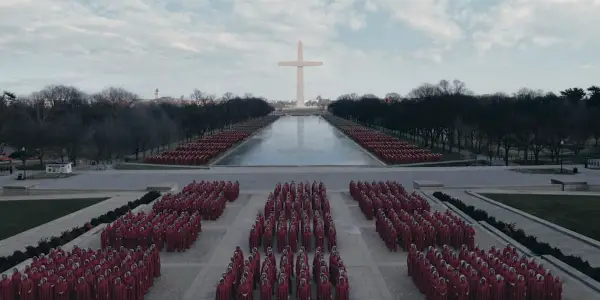
How often do current events like this impact the way you consciously design costumes for Handmaid’s Tale?
Natalie Bronfman: With the Handmaids’ outfit, I want to say it’s a Gandhi-esque way of protesting. In other words, it’s not violent; it’s not loud; it’s very quiet; but your presence is there. And the women are dressed in this red color with the striking white wings — you can’t miss that. It’s something that’s just so powerful.
Red is such an unusual color in that it has so many meanings to it. It can mean fertility, and it could also mean raging anger. [Or a] phoenix rising out of the ashes. So it has many, many meanings, but all of these are applicable there for this situation. When you look at it, it’s like a uniform. And it’s going to become a uniform again, and it’s going to become worldwide. Because all these countries — Poland is another country [that doesn’t allow abortions], Malta is another country, [and] there’s a few in the EU that don’t allow abortions either. This is a uniform that women wear during the protest. And they don’t have to say a word. They just have to show up. It’s very loud.
I’m always shocked at the range of expressivity you’re able to get out of the color palettes on Handmaid’s Tale. Especially compared to See, which has a lot of muted, neutral tones.
Natalie Bronfman: Color is such a powerful tool. I’m originally a painter, a fine artist, so I love playing with color. Each color represents different psychology as well and has meaning. For example, in the eastern world, white doesn’t mean the same thing as white does to the western world. So just those differences alone I like to play a lot within the characters once I’ve figured out with the actor who the character is supposed to be.
With See, for example, because it’s a world that’s very natural and nothing is available anymore, I had to go more into thinking about, how could they achieve colors at all? And because they cannot actually visualize the color, they have to be able to smell it or feel it or hear it. So you have to work with your other senses. Now when you do a lot of natural dying… for example, with avocado skins, you’ll get a beautiful lavender-pink color when you boil them. Weirdly enough. That’s how come we can use that color for Jason [Mamoa]. Also, that’s his favorite color palette, is the mauves and pinks. Or turmeric — that becomes a saffron orange-yellow. Or indigo is like a dark blue, so you can play a lot with those natural colors.
Each character got a color that was their own. Edo’s [color red] has to do with Julius Caesar and the Gallic Wars in 52 B.C. Queen Kane got the color of dried blood, basically. She went from that very first dress after she arrives at the palace, which is white, and has a big red splotch on the back, to slowly being much more saturated, where all the white went away and it was just head-to-toe dried blood. And then at the end, when she has leg irons, her nightgown because she’s no longer queen, she stabbed Cora in it, where she was covered in blood and all they basically did was wash out the nightie and give it back to her. So there are these watercolor stains of blood on it, and that’s why you have these splotches on there. It’s a beautiful arc.
Because of COVID, when we got back, I was given eight scripts at once to work on, which is daunting to say the least, because in one day you can be shooting five different episodes in one day, so you had to prepare the entire arc of everybody’s character at the same time, and you can’t deviate from schedules too much.
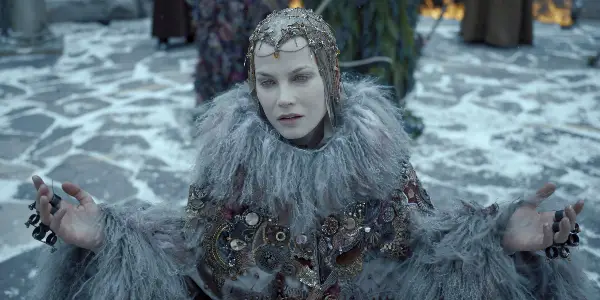
But I did the same thing with Maghra as well. Her character, when she landed, I kept her in the blue tones. And I was playing a bit with The Last Supper — Judas has the red, so there’s the blue and red, the good and bad, so I was playing around with that. And when she becomes queen, her outfit is green with blue in it, and that’s sort of to indicate that there’s a new spring coming for the land — there’s new growth coming. There’s hopefully peace and prosperity and fertility and all of that, so I play a lot with those colors. She still has the blues in it, and then the dress was covered in dried grasses and dried flowers and things like that. I can play with the colors that way.
Same with desaturating Tamacti Jun for a little while because he was going through so much. I actually took his clothing and made it not quite black anymore. It became more like a dull, faded charcoal grey because he was in such turmoil in his own head.
How do you approach stitching fabrics together for the show if the costumes are supposed to be made by characters who can’t see?
Natalie Bronfman: A lot of handwork was done on the show. With the exception of the main base seams, everything was done by hand. All the decorations, all the topical stuff was all done by hand. We did the main seams by a machine simply because we couldn’t have churned it out fast enough. What I did do with the seams was, I overlapped all the seams, so you saw the raw edges on the shoulders and cuffs. And there was no hemming, so everything was raw-edged, and then it was frayed a little bit because that’s what would happen naturally if you didn’t finish off a garment. [We also used] hand-felting, which created texture and thickness, and warmth.
The artisanal element on that was just beyond top-notch. I had such an amazing team. Because the ballet and the theaters in Toronto weren’t working because they were all shut down for COVID and I needed crew, I started calling around with my old friends, going, “Hi! I have this show… what are you doing?” [Laughs.]
Everyone’s free!
Natalie Bronfman: Yeah! There’s this weird divide between theater and film — you know, “Oh! I don’t work on film!” — but this was such a theatrical-film series. It was a giant feature, essentially. And I had three shoemakers on-staff. Who has shoemakers on a movie? It’s rare. So we ended up building all the main leads’ shoes. Maghra and Baba and all the boots were built.
What was the concept for the scenes where the characters aren’t in armor or dresses? Like the scene in Season Two, Episode Two, when Haniwa and Wren wander a furnished, dusty apartment dressed essentially like pirates — boots, loose high-waisted pants with no belts, and puffy button-up shirts.
Natalie Bronfman: In that particular scene, Haniwa was still in her clothing from when she was captured. She wasn’t really given new things. So these were things she left the House of Enlightenment in, and these were clothes that were, I want to say, army surplus–type things. And then, of course, they added things on the way, and the blankets and the wooly things were just to keep warm, which they grabbed out of the market as they were leaving.
And with Wren, it was, what would they have in that society? They would have pretty basic clothing, and the thing is, it’s textural, and it should be something that keeps them warm. It’s purposeful. It wasn’t just happenstance clothing.
At the start of pre-production, you must have had to figure out what materials and styles each of these societies have. So the Hidden Tribes are fur-heavy, indigenous and Inuit-inspired, for example. What was the logic behind some of the other civilizations we encounter?
Natalie Bronfman: Well, the Hidden Tribes — if I recall, there were four of them. I dived into the Dacians, then I had a little bit of an Arabic mishmash with it, then I also went into a tribe that mixed Māori with Mesoamerican… and I started going into tribal headgear and shapes. And so what I tried to do was incorporate the shapes — not necessarily the materials, but the shapes. Then there was, yes, indigenous Natives and Native tribes, where we used found objects. We actually used spools of thread to create chest plates.
It’s still keeping in with the found object thing — what would you have tossed away 600 years ago that didn’t disintegrate, other than diapers and tires? Although we did use tires! In the first season, they did create a whole city with plastic bottles that they crushed into bricks. So it’s that kind of a feel that I tried to continue on in the second season.
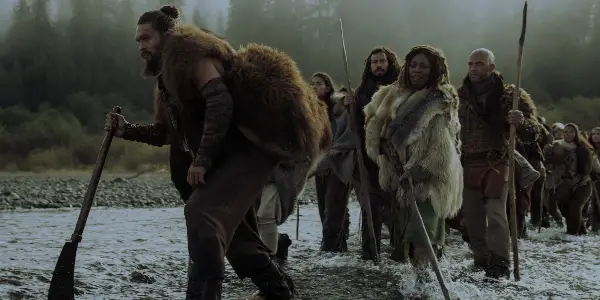
Another tribe actually comes from — they’re tree people — and they actually come from Pagan-Bulgarian rituals that still exist today. And if you Google it, you could see that they use a lot of straw, and there are these very scary monsters that are head-to-toe straw, and they have big fangs, and they’re oversized because they add another 4 feet of headspace. And it’s basically the spring festival — it’s to chase the winter away. So I was trying to incorporate some of history and some of Paganism and tribalism and then morph them into different tribes. And of course, what would they have? They would have a lot of fur because they’re all living in the wild and they would naturally eat these animals and then keep the fur for warmth as they do in Inuit populations because you couldn’t survive otherwise.
Are the furs real or fake?
Natalie Bronfman: They are actually real. Most of them. I’d say 90 percent are. I did get them from Native communities. They were communities where they themselves would hunt [the animals]. And I had a contact — one of the girls who worked with me, her partner was [Native American], and he was himself a hunter, so he had all these contacts.
Actually, the bear that Baba wears is from the 1970s. And the poor sucker was so dry — we kept having to oil it because it kept cracking on him. And the reason I knew it was from the ‘70s was that someone had signed inside of it. They had put a date on it in a ballpoint pen, which was just barely visible. And here’s a fun story for you — we needed a double for his stunt guy. Now it was a golden bear, meaning it had light blonde tips on it. So we actually had to do mesh foils on a brown bear in order to make it look the same. So it had highlights! And extensions put in!
But most of the fur that I did use was all fur that was not a wasted animal. Like, I didn’t use the blue fox. We had squirrels. We had deer. We had lamb — we had every kind of lamb on the planet, from Mongolia to Iceland, and they all had such different textural hairs. For example, Edo’s cloak, which looks like 1920s monkey fur — because in the ‘20s, that was really popular — it’s actually Icelandic sheep. And its hair is very long, and it’s just so luxurious and shiny and black, and it’s gorgeous, and when you put it on, you just turn into this majestic warrior. It was amazing. As soon as he threw that pelt on his back, I was like, “OK, you have to like this!” [Laughs]
And there are raccoon tails hanging off of Alfre Woodard’s character….
Natalie Bronfman: Yes! Well, actually, some of those are cougars and yeah, raccoons. They were all animals that wouldn’t be wasted. There was no mink or that kind of thing. And just to give you a sort of conservationist thing, once stuff goes into landfills, the “fun fur” is actually the worst thing to put in a landfill because it will never disintegrate, whereas natural leather and hairs will because carcasses do go back to the earth.
Now, seeking out furs sourced from Native communities — is that a practice that already exists in the costume design industry, or did you have to develop that relationship for See?
Natalie Bronfman: I went out of my way to do it because I always like to give back to the communities. I kept thinking [that] we’d tried fun fur, and it just didn’t look the same. It didn’t move the same. It didn’t break down the same. It just didn’t look real, and we had very expensive stuff, so it wasn’t a cost factor. And then I kept thinking, “This is all plastic! This is all plastic stuff.” And I thought If I lived in this community, where would I get my fur from? And it would be something that I’d caught and eaten. So that’s how I started, and I kept thinking, where could I get something like that?
[The shop assistant’s boyfriend] came in, and he actually gave me a lot of history about spirit bears and the different pelts and what they all mean, so that was really interesting. I had a great afternoon sitting down with him.I actually — and this is maybe a bit of a strange thing to do — I actually smudged the room often, and I would thank them for being there and being a part of our journey, which… I don’t tell everyone that because that’s a bit flaky, but… it’s only fair, to put it that way.

I do love Princess Maghra’s wedding dress, which is very Midsommar-esque, since it’s just all flowers all the way down in a long cloak. It’s beautiful.
Natalie Bronfman: Well, I was trying to figure out, how can I differentiate between male and female getting married, and then the cloak of course is because you can smell it and you can hear it rustle when she walks. Every flower had a symbol, so there’s purity and faithfulness and love and all of that.
And for Harlan, I kept trying to think, what’s a male flower or plant? And what I came up with was ferns because on the underside, they have spores, which is like sperm. [Shrugs] I mean, it’s a little out-there…
It’s very in-character for Harlan!
Natalie Bronfman: That’s why I created the fern coat for him! I thought, “Well….” [Laughs] And then you can eat fiddleheads, so it’s all of that.
Jason Mamoa’s battle armor has definite samurai elements to it, but the characters also have Roman components to the armor, too. How did you design that aesthetic cobbled together from different cultures?
Natalie Bronfman: Well, Jason’s was predominantly just samurai, from the Edo period. It’s funny because he wanted to be a samurai, and we were like, “OK!” — because I love Japanese culture — and I’m like, “Sure! Let’s do samurai!” And then we went to [episode writer] Jonathan Tropper, and he was like, “Well, where would he have gotten it from?!” So he had to write a scene where he goes and digs around Harlan’s armory and finds this armor in his perfect size. [Laughs]
With Edo and the Trivantians, it was a bit more cobbled together. His was more of a mishmash of feudal Japanese lamellar armor, those little plates that they have, and those pauldrons, I took them from medieval Mongolia, and then the rest of it was sort of ancient Greek, ancient Rome, cobbled together. Because the Trivantians were loosely based on an ancient Roman merchant town, or Rome, especially when they have that scene where you see the market, people from everywhere and everything is sold, and we sort of based it on that. [The materials] were all things that didn’t fall apart, that wouldn’t fall apart, cuz it’s armor, so I had to bear that in mind as well.
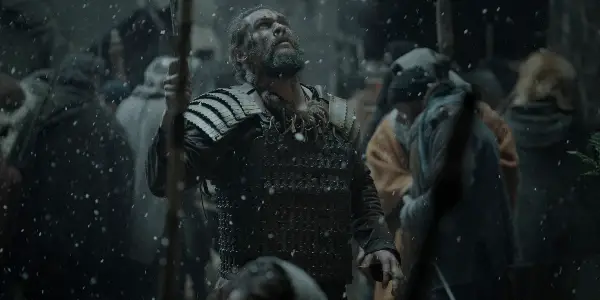
Many of the characters, because they’re blind and rely on sound and smell, have these practical components to their costumes. Queen Kane’s headpiece and rings jingle as she walks, like a bell on a lamb — which makes for a very funny dramatic handjob scene in the fifth episode that I love — but how and where did you add those practical components to the costumes?
Natalie Bronfman: It was either for specific positions that they had in society or jobs that they had. The tanner of leathers would have a different jingle or a different sound, as opposed to the army. The two different armies each had one boot that had a different noisemaking item. The Trivantians had two tambourine cymbals on the back so that when they would march and when they would step, you could hear them from miles away. And that’s an ancient Roman thing because the ancient Romans used to have hobnailed boots so that you could hear them coming from miles away, and that invoked fear already. The village would be going, “Oh my God! They’re coming!”
Whereas with the Payan army, we took the peephole from a door and broke the glass on one side and put ball bearings in it and put that on the Payan soldiers so they had a different noise, so you could tell who’s on which side.
Different nobles had different trinkets on them, some people had little wooden beads, and other people had metal beads or radio diodes. For example, Edo, when he was communicating with his army, instead of actually shouting out the orders, he had gloves on that had little metal pieces, and on his armor, he has like an apron. And on that apron are two metal things on either side of the hip. And he would clack on that — echolocation, which is something that people who can’t see use a lot. They’ll shout into a room or whistle. As Queen Kane does, when she first arrives at the palace and says, “What a lovely room,” because she hears how big and majestic it is. So this is the same. I was using a lot of echolocation in the clothing when I could. It’s a lot of fun to think about. I loved all that research.
Besides Season Three of See, the next show that you’re working on is Gotham Knights. Are you designing for the entire first season?
Natalie Bronfman: So far, I just did the pilot. I know it’s gone to series, but I don’t know when they’re doing that yet. Typically, when you do the pilot, you set the look and the style, the feel of the show, and if I don’t go on with it, then somebody else will have to maintain that same look. A similar thing happened on Handmaid’s — I couldn’t just walk in and change everything and suddenly the handmaids are wearing blue. In my opinion, it’s bad costuming when you decide to change everything. It disrupts the story visually, I think.
Speaking of sticking with an established look — how did you go about designing for the children of classic, beloved DC villains in Gotham Knights?
Natalie Bronfman: I look at my friends, or I look at myself, and I think, well, what are my sensibilities from me being raised by my parents? Obviously, as you grow into an adult, they change. But when you’re a teenager — because these are high school kids, pretty much — even though you might be rebelling, you still have, I wanna say, a subliminal sensibility of what your parents had, did looked like. So there’s that psychology that goes on with that. And what I tried to do, for example, with “Joker’s daughter,” is I pulled in his colors. And so we had the color scheme going on.
With Batman’s son, he was an adopted son who was in bad circumstances, was adopted and brought into this incredible wealth. Usually, when something like that happens, you can go one of two ways. You can either be super ostentatious or loud about it, or you can’t believe your luck and you’re afraid you’re going to lose it again, so you become very understated, respectful — and that’s who he was then. So we sort of crafted the characters and then of course spoke with the actors themselves, how they wanted to go with that. It was a lot of fun — I can’t tell you more, though!
So you have this big superhero show on the CW coming soon, and you have these two huge dystopian series — what other kinds of genres and stories do you want to design for next?
Natalie Bronfman: Oh, gosh. Anything, pretty much. I love a good challenge. Anything that involves research and history is probably my thing. When it’s dystopian, there are less rules. You can really create with the [other] creators as well — because I’m only one of a few creators on a show. There’s the production designer, the directors, the writers. We’re sort of vehicles to what their vision is. And I love that collaboration.
Dystopian anything is fun because of that. The sky’s the limit. You hash it out together in the production office and figure out what you want the show to look like. But yeah, See was just amazing because it was so much history, which is just my favorite.
It’s a fun show to nerd out about as you’re watching it.
Natalie Bronfman: Actually, on my Instagram, I post the costumes. Because sometimes we don’t see them, because it’s lit so darkly. I actually post the costumes and [break down] what and why and what’s the reason for it. I have a lot of interactions with [fans] about that. I get questions about stuff and gladly answer them. It’s a lot of fun.
See is currently streaming on Apple TV+, The Handmaid’s Tale is streaming on Hulu, and Gotham Knights is set to premiere on the CW in 2023. Season Three of See premieres on August 26th.
Film Inquiry would like to thank Natalie Bronfman for taking the time to speak with us.
Does content like this matter to you?
Become a Member and support film journalism. Unlock access to all of Film Inquiry`s great articles. Join a community of like-minded readers who are passionate about cinema - get access to our private members Network, give back to independent filmmakers, and more.
Film critic, Ithaca College and University of St Andrews graduate, head of the "Paddington 2" fan club.


